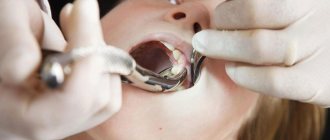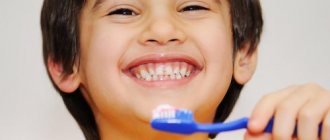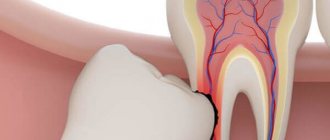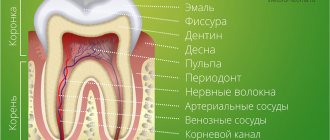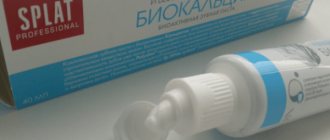How do dental tissues develop in humans?
Anatomically, a human tooth consists of a crown, neck and root. The visible part of the tooth is surrounded by hard tissues - enamel, dentin and cement, which protect the soft tissue - pulp. It extends from the crown of the tooth to its roots, has a large number of vessels and nerve endings and is directly involved in the nutrition of the entire tooth. Unfortunately, all tooth tissues undergo age-related changes, so in this case we are dealing with complex aging.
Dental development begins in the prenatal period. Already in the second month, the fetus develops an oral cavity with a dental plate. The rudiments of baby teeth form on it. By the fourth month, clear cell differentiation occurs. We can find anameloblasts, which are responsible for the formation of enamel, and dentinoblasts, which form the basis for dentin. By the sixth month, the outer and inner layers of dentin with a network of tubules are formed, and the gradual formation of pulp occurs, in particular the formation of collagen fibers.
Until what age do molars grow?
The process of replacing milk rudiments with permanent ones is extended over time. It can begin at age 6 and continue until age 14. Most often, permanent units fully grow by age 12. The first eight is usually achieved at the age of 18-20. It happens that wisdom teeth come in at 35 and 45 years old. Third molars may not appear at all. After all, the jaw of a modern person is slightly smaller in size than that of our distant ancestors.
As the permanent dental organ appears and grows, its roots thicken and their length increases. Enamel forms slowly. This takes about two years. The root masticatory organ usually appears without pain. Approximate growth periods:
- Central incisors – period from 6 to 8.5 years;
- The lateral incisors appear at 7.5 - 9 years of age;
- Fangs emerge at 9, 5, or even 12 years of age;
- Premolars appear by 10 years of age, and may appear even at 12 years of age;
- First molars – period from 6.5 to 7.5 years;
- Second molars – from 11 to 13 years;
- Wise units appear by the age of 17, and may even appear by the age of 21.
These norms are conditional. There is no need to worry if there are minor deviations. The formation of dentition occurs in different ways, depending on a number of factors.
Until what age do human teeth grow?
Baby teeth begin to erupt before one year of age. As a rule, at 2-2.5 years a child receives a full set of baby teeth. The molars are located immediately behind the milk teeth: between them there is a partition that is destroyed during the eruption of permanent teeth. The change of teeth in a person begins at the age of 6-7 years: the upper incisors usually fall out first. The milk bite is replaced by a permanent one at about 12-13 years of age. Molars develop more slowly than baby teeth, and the roots of wisdom teeth can continue to form up to 23 years of age and even later.
Until what age do baby teeth grow in children?
The rudiment of the chewing organ is formed in the uterine period. The first temporary units can begin to appear as early as two or three months, but most often this occurs at 4-6 months. The sequence of their growth is definite.
- The lower central incisors emerge first.
- Then the eruption of the upper units is noticeable.
- Then pairs of lateral incisors appear.
- Next, the first molars, canines, and second molars are shown.
Children's milk teeth, in the amount of 20 units, appear by the age of 3-4 years. A gradual change from temporary chewing organs to permanent ones can occur at 5 years. But, most often this happens at six years old. The first molars are the first to be lost. The order of changing units is the same as the sequence of growth. Many mothers and fathers think that temporary crowns are not susceptible to caries. This is mistake.
Time unit therapy is mandatory. Treatment should be carried out on time, otherwise the pathology will affect the root organs, which are deeper than the mammary organs. To prevent problems, have your mouth cleaned at your dentist's office. Parents should teach the little one to properly maintain hygiene, clean their chewing organs twice a day, and rinse their mouth after eating.
Age-related changes in dental growth and development
As soon as teeth (both milk and permanent) begin to erupt, they become vulnerable to the external environment, but at the same time they acquire a protector in the form of saliva, which not only helps destroy bacteria, but is also directly involved in saturating the teeth with various minerals. The first to experience age-related changes are enamel and dentin. Every year, due to the erosion of enamel, our teeth decrease in height. The average is about 0.035 millimeters per year, but some people experience increased tooth wear due to anatomical features and bad habits. The color and structure of the enamel change: more and more dyes accumulate in it, which leads to yellowing and loss of shine. Cracks and microdamages form on the surface of the enamel, where plaque penetrates. Over time, it mineralizes and prevents the penetration of organic substances and beneficial microelements into the enamel. It should be remembered that enamel cannot be restored, so in case of damage or illness, you should consult a doctor promptly and not wait for complications to arise. As for dentin, over the years it regenerates more and more slowly, and the quality of replacement dentin also becomes worse.
How long does it take for teeth to grow?
The formation of milk elements begins during the period of fetal development - the dental plate is formed in the second month, and by the middle of the period it is possible to identify the cells responsible for the structure of the structure of enamel and dentin. The pulp and dentinal layers are outlined towards the end of the second trimester, paralleling the process of formation of the collagen fibrous structure. The eruption of baby teeth begins 9-11 months after the birth of the child, and by the age of two or three years a complete set has already been formed. The radical units are located directly behind the dairy ones - initially they are separated by a small partition, which gradually collapses as the permanent elements grow.
The starting point in changing the bite is considered to be the age of 6-7 years: the process begins with the frontal incisors of the upper jaw, and lasts until adolescence, ending at the age of 13. It is worth noting that molars take longer to form and develop than primary ones - this is especially true for “eights”, or wisdom teeth, which in some cases bother their owners at an older age.
Age-related changes in dental pulp
Regressive and age-related changes in the dental pulp also affect dental health. Over the years, the pulp decreases, and fibrous changes are often observed in its tissues. Mineral deposition negatively affects the condition of blood vessels and capillaries. Atherosclerosis of pulp vessels occurs in many people over 50 years of age. Because of this, tooth tissues no longer receive proper nutrition, which is why they become more fragile and vulnerable. Many people are interested in how to determine a person’s age by looking at their teeth. Only a medical examination can provide more or less accurate data. It is very difficult to determine a person’s age by looking at their teeth, since even relatively young people’s teeth can be in very poor condition, and vice versa.
In what order do teeth appear?
Usually baby teeth erupt in pairs. If, for example, the left central incisor appears, then after some time the right one begins to grow. In what order this happens does not matter.
Research shows that sometimes the eruption of baby teeth in infants occurs with a delay of one to two months, which may be due to a genetic factor, the mother’s health during pregnancy, climatic conditions, etc.
If the delay is longer than the specified period, we recommend showing the baby to a specialist.
We recommend that your child's first visit to the dentist be between the ages of six months and nine months. At the appointment, a specialist will conduct an examination and give recommendations on oral hygiene: which toothpastes and brushes are best to use, how to brush your teeth correctly.
Age-related changes in bone tissue and gums
In addition to age-related changes in teeth, over the years a person, as a rule, decreases bone density and its height. Osteoporosis of the jaw often occurs in older people. The clinical picture is aggravated by adentia (partial or complete) and poor-quality dentures, due to which the distribution of the chewing load is disrupted. Changes can affect not only hard but also soft tissues. Age-related gum recession occurs both due to previous diseases (for example, periodontitis), and due to poor genetics, poor lifestyle and bad habits, especially smoking. At an advanced stage, this leads to loosening and loss of teeth.
How does the growth process of molars occur?
At 12-13 years of age, a child, as a rule, no longer has milk teeth, although their roots dissolve earlier. At this point, there are part of the molars in the mouth with fully and partially formed roots.
Dental roots go through 2 stages in their development:
- the period of unformed apex (the root is still as long as possible, the walls are parallel, the canal is wide);
- the stage of an unclosed apex (the formation of the apex ends, the walls of the canal come closer together).
The roots of the lower jaw form faster than the upper jaw. This process also has approximate deadlines, but they can shift in both directions. Therefore, it is definitely impossible to answer the question at what age children develop permanent teeth - canines, incisors or molars. As with dairy products, everything is individual here.
How can you avoid age-related changes with the help of modern dentistry?
Even though our teeth age along with the rest of our bodies over the years, this does not mean that it is impossible to maintain an attractive and healthy smile in old age. Rule number one is good daily hygiene. Rule number two is regular preventive visits to the dentist. Professional cleaning will help remove hard plaque and prevent the development of caries, and the remineralization procedure improves the condition of the enamel. Laser and physical therapy are now actively used to strengthen gums, therefore, if you have problems with periodontal disease, it is recommended not only to visit a specialized specialist, but also to monitor the health of your gums at home. Rule number three is a balanced and healthy diet, coupled with taking vitamin complexes. This will help not only the teeth and oral cavity, but also other systems of the body.
Publisher: Expert magazine about dentistry Startsmile.ru
Author of the material: Yaroslav Ikonnikov
Timing of eruption of permanent teeth in children
Hurry up! Before the start of the summer holidays, there is a unique opportunity to take advantage of a 15% discount on pediatric dentistry!
Interactive dental formula
The timing of teething can characterize both the biological and passport age of the child. The process and timing of teething depend not only on inherited genetic parameters. The timing of teething can be influenced by external and internal factors (climatic conditions, diet, quality of drinking water, etc.). In this regard, the timing of the eruption of permanent teeth varies in different regions.
During a person’s life, 20 teeth change once, and the remaining 8-12 teeth do not change; they erupt initially as permanent teeth (molars).
By the age of three, all baby teeth erupt in a child, which by the age of 5 begin to gradually be replaced by permanent ones.
There are 20 primary teeth in total: on each jaw there are 4 incisors (4 central teeth), 2 canines (third teeth) and 4 molars (fourth and fifth teeth).
An adult normally has 28-32 permanent teeth: each jaw has 4 incisors, 2 canines, 4 premolars and 4-6 molars. The development of the third molar (“wisdom tooth”) may not occur at all (with congenital edentia of the third molars), which is also considered normal. Another situation is also possible: a wisdom tooth is embedded in the thickness of the jaw, but never erupts (due to incorrect position or lack of space in the jaw). This situation occurs very often.
After all the baby teeth have erupted, there are no gaps (gaps, gaps) between them, which is normal. But as the jaw grows, before the baby teeth are replaced by permanent ones, gaps should appear between the baby teeth. This process is necessary because permanent teeth are larger in size than baby teeth and if spaces are not formed, then the permanent teeth do not fit in the jaws and the child receives “crooked” permanent teeth.
In parallel with the formation of spaces between temporary teeth, the roots of baby teeth are “reabsorbed”, after which the teeth alternately become loose and fall out.
There is no general opinion about the normal timing of the eruption of permanent teeth, since scientific studies by different authors were carried out in different regions and in different years of the last and present centuries. Here are the norms for the eruption of permanent teeth according to several authors:
Central incisors 5-6 years (Vinogradova T.S. 1982) 6-8 years (Kolesov A.A. 1985) 7-8 years (Magid E.A. et al. 1987, Bykov V.L. 1998) 6- 9 years (Kalvelis D.A. 1994)
Lateral incisors 7-9 years (Vinogradova T.S. 1982) 8-9 years (Kolesov A.A. 1985, Magid E.A. et al. 1987, Bykov V.L. 1998) 7-10 years (Kalvelis D .A. 1994)
Fangs 12-13 years (Vinogradova T.S. 1982, Bykov V.L. 1998) 9-11 years (Kolesov A.A.1985) 10-13 years (Magid E.A. et al. 1987) 9-14 years (Kalvelis D.A. 1994)
First premolars 9-11 years (Vinogradova T.S. 1982, Bykov V.L. 1998) 9-10 years (Kolesov A.A. 1985, Magid E.A. et al. 1987) 9-13 years (Kalvelis D .A. 1994)
Second premolars 9-11 years (Vinogradova T.S. 1982) 11-12 years (Kolesov A.A. 1985, Magid E.A. et al. 1987, Bykov V.L. 1998) 10-14 years (Kalvelis D .A. 1994)
First molars 4.5 -7 years (Vinogradova T.S. 1982) 6 years (Kolesov A.A.1985) 5-6 years (Magid E.A. et al. 1987) 5-8 years (Kalvelis D.A. . 1994) 6-7 years (Bykov V.L. 1998)
Second molars 12-13 years (Vinogradova T.S. 1982, Kolesov A.A. 1985, Magid E.A. et al. 1987, Bykov V.L. 1998) 11-14 years (Kalvelis D.A. 1994)
Third molars (“wisdom teeth”) 18-25 years (Magid E.A. et al. 1987) 18-20 years (Kalvelis D.A. 1994) 18-30 years (Bykov V.L. 1998)
Here is the most common sequence of eruption of permanent teeth:
- First molars ("sixth teeth")
- Central incisors
- Lateral incisors
- First premolars ("fourth teeth")
- Canines (“eye teeth”) and/or second premolars (“fifth teeth”)
- Second molars ("seventh teeth")
- Third molars ("wisdom teeth")
Important! Each baby tooth is normally loosened and replaced with a permanent one.
Central primary incisor on the permanent one of the same name
Lateral primary incisor on the permanent one of the same name
Milk canine to permanent canine of the same name
First primary molar to first permanent premolar ("fourth tooth")
Second primary molar to second permanent premolar ("fifth tooth")
First permanent molar ("sixth tooth")
appears immediately permanent at 5-7 years.
Second permanent molar ("seventh tooth")
appears immediately permanent at 9-12 years of age.
Therefore, even if your child has not lost a single milk tooth at the age of 5-7 years, this does not mean that he does not have permanent molars (“sixth teeth”). The appearance of these teeth is not always accompanied by fever and general malaise.
Also, do not despair and panic if a child aged 5-7 years has a fever and is not eating well, perhaps his first molars are cutting!
A.I. Rarely dentist
2013



